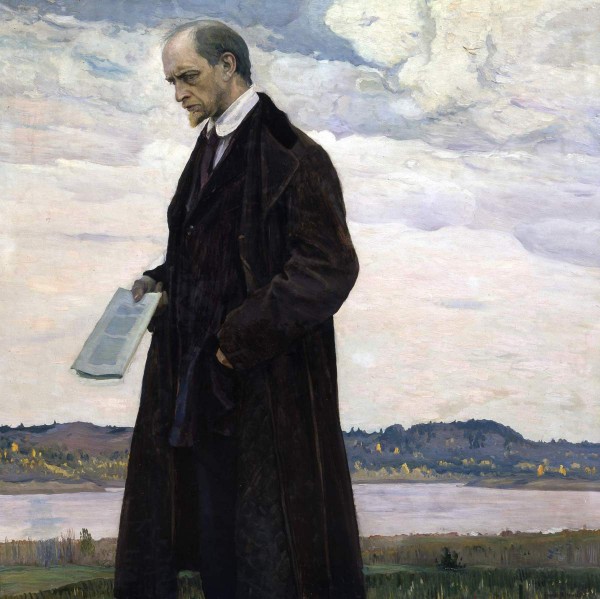The artist is Nesterov

Portrait and. A. Ilyina is one of the most significant works written by the artist after a long break associated with the difficult period of the revolution and the Civil War. In it, Nesterov is trying to create a picturesque portrait of a different type. The picture was started in the summer of 1921, soon upon returning from Armavir, where the artist was forced to live about two years due to military events in the country. Vasily Baksheev – a longtime comrade Mikhail Vasilyevich, who “peasant” in the village, invited him to spend the summer with his family in their oaks. In one of the letters, Nesterov reports that “starts a portrait from one of our wonderful philosopher scientists”. The choice of the model speaks of the views of the artist and his civil courage. Ilyin with all his might opposed the pressure of the new government, for which he was arrested several times. Nesterov wrote it as “a giant, rooted in his native land, immersed in the world of moral searches and deep thoughts”. The portrait was completed in July next year, and in September the philosopher was arrested for the sixth time. The death sentence was replaced by expulsion from the country. In October, Ilyin, together with a group of Russian writers and philosophers, was expelled from Russia. (A. N.).
Ilyin Ivan Alexandrovich (1882–1954) – philosopher, professor of Moscow University; The largest Russian religious thinker, a fiery patriot, one of the few, which can be classified as “as teachers, spiritual and historical drivers of the Russian people”. In 1922 he was expelled from Soviet Russia.
Russian portrait. XX century: St. Petersburg, 2001. WITH. 175.
In 1922, Nesterov finished work on the “thinker (portrait and. A. Ilyina) ” – one of the first significant works of the post -October period, a picture, today is truly invaluable as a truthful and tragic document of the era.
The image of Ivan Ilyin, the outstanding philosopher and publicist, the preacher of “opposition to evil by violence” and one of the spiritual leaders of Russian emigration, as if embodied the generalized type of Russian intellectual scientist, involved in the brutal whirlpool of political life. In the appearance of the depicted, deeply thought over the text just read, there is nothing from the barrel condescension of the educated people of the last three reigns who dreamed of the good of the people and honest, free work. Ilyin – the whole clot of active energy, a lump of nerves, obsessed with the search for truth and a thirst for struggle. In its temperament and even in appearance, it is rather close to fanatical Bolshevik leaders than its reflexive predecessors.
The characteristic of the portrait is subtly complements the Russian landscape – autumn, cloud, gloomy. He seems to expose the secret thoughts of Ilyin – about the homeland, about Russia, its people and fate.
Of course, people like Ilyin could not get along with the new government. In the year of the completion of the portrait, the philosopher, together with many of his associates, was put on a “philosophical ship” and expelled by decision of the Politburo of the RCP (b) abroad. The path of knowledge of your country and your people ended for the Russian intellectual elite in a foreign land. Pavel Klimov. Lone wanderer // Mikhail Nesterov. SPb, 2012. WITH. 188-189.
Ilyin Ivan Alexandrovich (1882–1954) – philosopher, professor of Moscow University. In 1922 he was expelled from Soviet Russia.